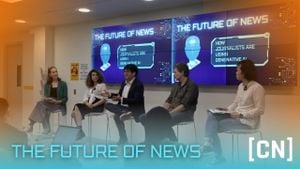Nippon Steel, Japan's largest steel manufacturer, has stirred significant controversy with its proposed acquisition of U.S. Steel, valued at $15 billion. The potential deal isn't just raising eyebrows within the industry; it's igniting political discussions, attracting the attention of figures like President Joe Biden and President-elect Donald Trump. Both have expressed strong reservations, arguing for the importance of keeping U.S. Steel under American ownership. Trump has voiced concerns about the need for U.S. Steel to remain American-owned, reflecting broader anxieties about foreign acquisitions of American companies.
Despite political pushback, many analysts and industry insiders posit this merger as pivotal for the future of U.S. Steel—a company described as “a shell of its former self” after struggling with profitability for over 15 years. The acquisition could be seen as a rescue operation, offering systemic stability and revitalization to U.S. Steel, which has faced considerable financial duress and competition from global players.
The union representing U.S. Steel’s workforce, the United Steelworkers (USW), is particularly vociferous against the merger. With more than 1.2 million current and retired members, USW has made its worries known, fearing for the security of jobs, adherence to labor agreements, and the future of local communities reliant on U.S. Steel's operations. The union's mistrust is rooted deep, stemming from recent arbitration failures where they attempted to halt the acquisition, citing concerns over Nippon's commitment to jobs, transparency, and potential impacts on national infrastructure and defense.
These anxieties stem from not just business metrics but the very cultural ethos of employment management. Japanese corporations, including Nippon Steel, employ models rooted deeply in lifetime employment, particularly within manufacturing sectors. This archaic approach bears stark contrasts with the relatively transient nature of workforce commitments within U.S. corporations, where the average employee tenure is approximately 3.9 years compared to Japan’s 12.3 years.
While the existing labor laws provide substantial support for employees against termination within Japan, U.S. workers find themselves often at the mercy of employment-at-will doctrines. Such contrasting labor practices only heighten the stakes surrounding this acquisition, where potential shifts to employee retention strategies under Nippon’s model could lead to significant changes for the American workforce.
On the flip side, some U.S. Steel workers and stakeholders eagerly endorse the deal. Families with deep-rooted ties to U.S. Steel, particularly those in regions like Pittsburgh, suggest the acquisition could bring about much-needed financial stability. They argue Nippon’s investment would revive local economies, particularly benefiting small towns reliant on U.S. Steel’s operations. This divergence of opinion points to the broader debate over economic revitalization versus traditional labor practices.
Yet, these shifting dynamics suggest more than just potential layoffs or job preservation; they hint at how corporate culture may alter the fabric of American employment. Japan’s workplace culture fosters collaboration between labor and management—a far cry from strategies utilized by American unions, which often resort to strikes during disputes. Instead, the Japanese “Shuntō” system offers annual negotiations for wage increases, fostering greater cooperation and security for its workers.
With USW’s apprehensions laid out clear, it’s also pertinent to explore how Nippon Steel’s management style could shift operational approaches at U.S. Steel. Nippon might usher in practices prioritizing training, development, and job security, aspects of the workforce dynamic American employees have historically lacked. Nippon Steel’s approach could revolutionize employee relations, fostering trust and collaboration rather than division and distrust.
While the merger stands at the crossroads of politics and business, it also touches on cultural imperatives shaping communities and families across America. If Nippon Steel manages to complete the acquisition, it could set the stage for transforming the traditionally contentious relations between steelworkers and management—turning fears of job losses to opportunities for improved workplace stability.
Though the acquisition remains pending approval, the broad implications for American labor dynamics and cultural shifts within one of the country’s oldest industries cannot be overstated. Stakeholders from both sides of the aisle have much to ponder as they gauge the future of this extensive yet contentious deal, casting light on larger conversations surrounding globalization and American labor standards.



